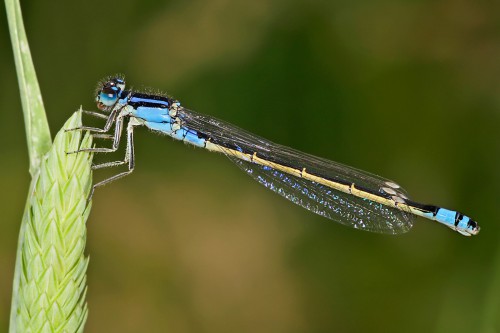
Updated July 2016
Materials:
- Google Slides (Public) – includes directions and photos of damselflies
- Lesson Plan – (pdf-Instructions)
- Images to print out and laminate (pdf)
- 1 Index card per team
I used this activity with my 6th graders to emphasize observations, communication skills, and team work. It is a variation on the classic Telephone Game that many students are familiar with. Depending on the number of students you have, I found that 7-8 per team worked really well. The more students on a team, the more difficult it is to relay the information to each student, and less than 7 was much easier. If your teams aren’t exactly even, that is ok. When grouping students, be sure to mix abilities and plan accordingly for teams that are larger/smaller.
How the game works is I have 10 color photos of damselflies, and each team will make & share observations for one of the photos. The only person who will see the photo, however, is person #1. The rest of the team will not see the photo, and they don’t know what the photos are of. The only information they will have are the 10 observations person #1 will give them. Once each group determines who #1 is, #1 will come up to make and record 10 observations about their photo for 3 minutes. The rest of the team will determine who will receive the information from #1 and the order they will go in. Some strategies will go into determining the order, for example, someone who has a really good memory may want to be person #2.
Students will spread out around the room and take a seat. When the 3 minutes are up, person #1 will go to person #2 and whisper the 10 observations to them for 1 minute. Person #1 will have their index card, but can not give the index card to person #2. Person #2 can ask questions and repeat the information until the 1 minute is up. #1 will take #2’s seat and #2 will go to #3 and share the 10 observations from memory. This will continue until all members have had a turn sharing the observations.
The last member of the team will share the observations with the class and then pick out the photograph from the 10 I have. We will then compare the last set of observations to the original 10 and find out if they were able to choose the correct photo.
This was a fun and challenging activity, and it lead to some really great discussions about making and sharing observations. Many groups had difficulty picking out the original photograph because the information changed or went missing somewhere along the line, just like when they play the game telephone.
NGSS SCIENCE AND ENGINEERING PRACTICES (SEP 1, SEP 4, SEP 8)
- Asking Questions and Defining Problems
- Analyzing and Interpreting Data
- Obtaining, Evaluating, and Communicating Information